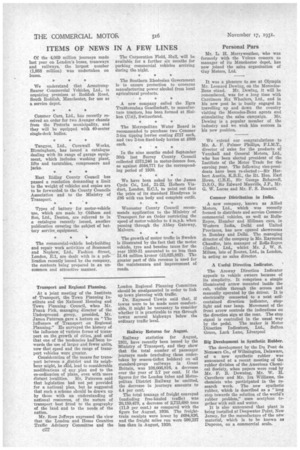Transport and Regional Planning.
Page 44

If you've noticed an error in this article please click here to report it so we can fix it.
At a joint meeting of the Institute of Transport, the Town Planning Institute and the National Housing and Town Planning Council, when Mr. Prank Pick, managing director of the Underground ,group. presided, Mr. James Paterson gave a lecture on "The Influence of Transport on Regional Planning." He surveyed the history of the influence of various forms of transport on the growth of cities, and said that one of the tendencies had‘been towards the use of larger and fewer units, now that speed and the range of transport vehicles were greater.
Consideration of the means for transport between a.sdistrict and its neighbour might, he said, lead to considerable modifications of any plan and to the co-ordination of plans, even with more
distant localities. Mr. Paterson said that legislation had not yet provided for a national plan, but he suggested that such a scheme should be drawn up by those with an understanding of national resources, of the nature of transport best fitted to the geography of the land and to the needs of the nation,
Mr. Rees Jeffreys expressed the view that the London and Home Counties Traffic Advisory Committee and the c22
London Regional Planning Committee should be amalgamated in order to link up town planning with traffic.
Dr. Raymond Unwin said that, if towns were to be made more comfortable, it might be necessary to consider whether it is practicable to run through towns several highways below the ordinary traffic level.
Railway Returns for August.
Railway statistics for August, 1931, have recently been issued by the Ministry of Transport, and they show that the total number of passenger journeys made (excluding those undertaken by season-ticket holders) on -all standard-gauge railways in Great Britain, was 108,666,816, a decrease over the year of 3.7 per cent If the figures for the London tubes and Metropolitan District Railway be omitted, the decrease in journeys amounts to 4.4 per cent.
The total tonnage of freight conveyed (excluding free-hauled traffic) was 20,159,479, a decrease of 2,715,680 tons (11.9 per cent) as compared with the figure for August, 1930. The freighttrain receipts were lower by £694,826, and the freight miles run were 599,22'7 less than in August, 1930.












































































































